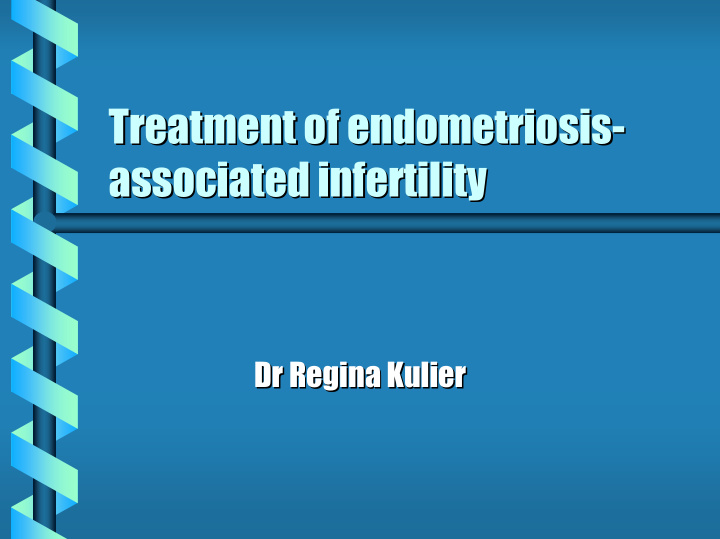



Treatment of endometriosis- - Treatment of endometriosis associated infertility associated infertility Dr Regina Kulier Dr Regina Kulier
Background Background � aetiology: � retrograde menstruation implant � metaplasia of coelomic cells � haematogenous/lymphatic spread � immunologic � prevalence: 20% - 40% (Mahmood 1991) � revised American Fertility Society classification (1985)
Treatment options options Treatment � Medical (drug induced ovarian suppression) � Surgical (laparoscopy, laparotomy) � In vitro fertilisation
Ovulation suppression Ovulation suppression � danazol, MPA, gestrinone, COC, GnRHa versus placebo/no (4 RCTs) � any ovulation suppression versus danazol (8 RCTs) Hughes E. et al. (Cochrane systematic review) In: The Cochrane Library
Pentoxifylline Pentoxifylline � Pilot study, RCT (n=60) � rAFS I, II � Pentoxifylline 800mg/d vs placebo (12months) � pregnancy rates: 31% (Pe) vs 18.5% (Pl) Balasch J. Hum Reprod 1997
Surgical treatment Surgical treatment � laparoscopy/ laparotomy versus medical treatment/no treatment 2 meta-analyses, 22 cohort studies Hughes E. Fertil Steril,1993;59:963, Adamson G. Am J Obstet Gynecol 1994 ;171:1488
Surgical treatment Surgical treatment � RCT, laparoscopy: resection/ablation versus diagnostic 341 infertile women with minimal or mild endometriosis Marcoux S. NEJM 1997; 337:217
Fecundity rates and cumulative probabilities of pregnancy (Marcoux 1997) Outcome Laparoscopic Diagnostic RR (95% CI) surgery (n=172) laparoscopy (n=169) Pregnancies 50 29 1.69 (1.13-2.54) carried beyond 20 weeks (No) Fecundity 4.7 2.4 1.9(1.2-3.1) rate/100 person months 36-weeks 30.7 17.7 1.7(1.2-2.6) cumulative probability (%) Recognised 63 37 pregnancies (No) Fecundity 6.1 3.2 1.9(1.3-2.9) rate/100 person months
IVF IVF � retrospective retrospective � � 140 patients /182 cycles with EM 140 patients /182 cycles with EM � � GnRH GnRH nasal 1.5mg/14 days nasal 1.5mg/14 days � � HMG HMG � � Progesterone 200mg/d for 10 days after Progesterone 200mg/d for 10 days after � embryo transfer embryo transfer Geber S. Hum S. Hum Reprod Reprod 1995;10(6):1507 1995;10(6):1507 Geber
Pregnancy outcome and implantation rate after IVF using GnRH analogues (Geber S. Hum Reprod 1995) Groups No of Implantation Pregnancy Miscarriage cycles rate rate/transfer rate 1) Male factor 45 23.4% 39%(9/23) 0 2) Unexplained 196 27.6% 48%(76/159) 3.9%(3) 3) Tubal factor 1136 23.4% 45%(465/1039) 3.4%(16) 4) Endometriosis 129 21.8% 40%(44/110) 0
Implantation rate and pregnancy outcome after IVF using GnRH analogues according to the stage of endometriosis (Geber S. Hum Reprod 1995) AFS stage No of cycles Implantation Pregnancy Miscarriage rate rate/transfer rate I-II 100 19% 35.0% (29/83) 0 III-IV 29 28% 55.5% (15/27) 0 The difference between the pregnancy rates/transfer was 20.5% (95%CI: –0.8 to42)
IVF IVF � retrospective � objective: impact of endometriosis stage on IVF outcome � endometriosis vs tubal infertility Oliviennes F. Fertil Steril 1995;64:392
All endometriosis patients and tubal controls (Oliviennes F Fertil Steril 1995) All endometriosis patients and tubal controls Outcome Endometriosis Tubal factor (n=111, (n=214, cycles =360) cycles=160) Clinical 35.9% (104/290) 41.9%(57/136) pregnancies/transfer Deliveries/transfer 30.0% (87/290) 37.5% (51/136) Miscarriage 16.4% (17/104) 10.5% (6/57)
Pregnancy outcomes according to subgroups Outcome Endometriosis only Endometriosis and Endometriosis and Mechanical factor (cycle n=236) tubal factor (cycle male factor (cycle (cycle n=160) n=63) n=61) Clinical 80/204 (39.2%) 8/44 (18.2%) 16/42 (38.1%) 57/136 (41.9%) pregnancy /transfer Deliveries/ 72/204 (35.3%) 5/44 (11.4%) 10/42 (23.8%) 51/136 (37.5%) transfer Miscarriage 8/80 (10%) 3/8 (37.5%) 6/16 (37.5%) 6/57 (10.5%)
Intrauterine insemination Intrauterine insemination � RCT: RCT: superovulation superovulation (FSH) and intrauterine (FSH) and intrauterine � insemination insemination � 103 couples with minimal / mild 103 couples with minimal / mild � endometriosis endometriosis Tummon S. Fertil Steril 1997;68:8-12
Intrauterine insemination Intrauterine insemination � Live births Live births � � superovulation superovulation /IUI: /IUI: � � 14/127 (11%) 14/127 (11%) � � no treatment: no treatment: � 4/184 (2%) � 4/184 (2%) �
Conclusion 1 Conclusion 1 � Ovulation suppression Ovulation suppression � � lack of evidence to support ovulation suppression lack of evidence to support ovulation suppression � for treatment of em em- -associated infertility associated infertility for treatment of � disadvantages: side effects, loss of time, cost disadvantages: side effects, loss of time, cost � � Pentoxifyllin Pentoxifyllin � � cannot be recommended at this stage cannot be recommended at this stage �
Conclusion 2 Conclusion 2 � Surgical treatment (laparoscopy/laparotomy) Surgical treatment (laparoscopy/laparotomy) � � limited evidence to suggest surgery might be limited evidence to suggest surgery might be � better than no treatment better than no treatment
Conclusion 3 Conclusion 3 � IVF: IVF: � � similar rates of pregnancy in women with endometriosis and similar rates of pregnancy in women with endometriosis and � other causes of infertility (retrospective data) other causes of infertility (retrospective data) � no comparison between IVF and other treatments have been no comparison between IVF and other treatments have been � made made � Superovulation Superovulation and intrauterine insemination and intrauterine insemination � � could be beneficial, more evidence needed could be beneficial, more evidence needed �
Recommend
More recommend